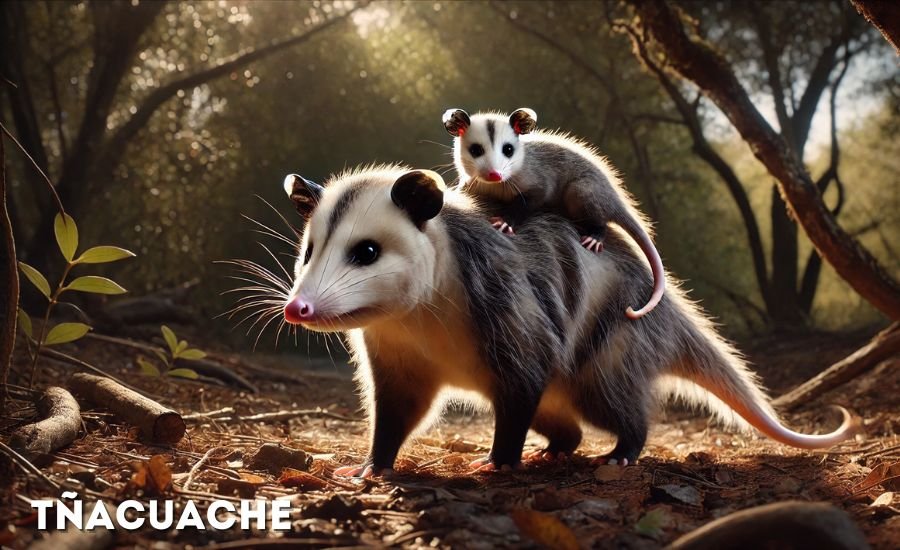The Tñacuache: A Comprehensive Guide to Understanding the Opossum

The tñacuache, commonly known as the opossum in North America, is a marsupial that plays a vital role in various ecosystems across the Americas. Despite being misunderstood and often viewed as a pest, the tñacuache offers significant ecological benefits, such as controlling insect populations and promoting seed dispersal. This article will delve into the fascinating world of the tñacuache, exploring its physical characteristics, habitat, behavior, diet, and importance in maintaining ecological balance.
By the end of this guide, you will have a deeper appreciation of the tñacuache’s role in nature and why this often-overlooked creature deserves our respect and protection.
What is a Tñacuache?
The tñacuache is a marsupial, which means it carries its young in a pouch, much like kangaroos. Scientifically known as Didelphis virginiana, it is the only marsupial found in North America. The term “tñacuache” is primarily used in Latin American countries to describe this adaptable and resourceful animal, which has thrived in various habitats due to its omnivorous diet and unique survival strategies.
Physical Characteristics
The tñacuache is easily identifiable due to its distinct features:
- Size: Typically, an adult tñacuache measures between 12 to 20 inches in body length, excluding its tail, which can add another 10 to 16 inches.
- Weight: They generally weigh between 4 to 11 pounds, though this varies depending on habitat and food availability.
- Fur: Their coarse fur is usually a mottled gray and white, providing a camouflage effect in various environments.
- Tail: The long, prehensile tail is one of their most distinctive features, allowing them to grip branches and aid in climbing.
- Teeth: With 50 sharp teeth, the tñacuache has the highest tooth count of any North American mammal, which helps it consume a wide variety of foods.
Habitat and Distribution
The tñacuache’s adaptability is one of its most remarkable traits, allowing it to inhabit regions as diverse as tropical forests, wetlands, suburban areas, and even urban environments.
Preferred Habitats
- Forests: Dense forests provide tñacuaches with ample cover, food, and nesting sites. They particularly thrive in areas with abundant tree cover and undergrowth.
- Wetlands: Wetland ecosystems offer a rich supply of insects, small animals, and plants, which make up a significant portion of the tñacuache’s diet.
- Urban Areas: In cities and towns, tñacuaches are often seen scavenging through garbage bins and compost piles, taking advantage of human waste as a food source.
Geographic Range
The tñacuache is widely distributed across the Americas, from southern Canada to northern Argentina. They are highly adaptable and can survive in diverse climates, from cold northern winters to the warm tropics of Central and South America.
Nocturnal Behavior and Survival Tactics
One of the reasons tñacuaches have thrived for so long is their nocturnal lifestyle. Being active at night helps them avoid predators and competition while foraging for food.
Playing Dead: The Ultimate Defense Mechanism
When faced with danger, tñacuaches are famous for their unique survival tactic known as “playing dead” or thanatosis. When threatened by predators, the tñacuache will collapse, appear lifeless, and even emit a foul odor resembling decaying flesh. This trick is highly effective, as many predators lose interest in what seems like a dead and rotting animal.
Hissing and Showing Teeth
If playing dead doesn’t work, tñacuaches can become defensive, hissing loudly and showing their 50 sharp teeth to intimidate potential threats. Although these displays may seem aggressive, they are more about defense than offense, as tñacuaches prefer to avoid confrontations.
Diet: A True Omnivore
Tñacuaches are omnivores, which means they eat both plant and animal matter. This wide-ranging diet is one of the keys to their survival in so many different habitats.
What Do Tñacuaches Eat?
- Fruits and Vegetables: Tñacuaches enjoy fruits like berries, apples, and grapes, as well as vegetables such as corn and carrots.
- Insects: Insects such as beetles, crickets, and moths make up a large portion of their diet, helping to control pest populations.
- Small Animals: Tñacuaches are opportunistic hunters and may prey on small mammals, birds, and reptiles when the opportunity arises.
- Carrion: As scavengers, tñacuaches play an important role in the ecosystem by consuming dead animals, helping to prevent the spread of diseases.
- Human Waste: In urban environments, tñacuaches are often seen scavenging for leftovers in garbage bins, compost heaps, and gardens.
Ecological Importance of the Tñacuache
Despite being viewed as pests by some, tñacuaches play an essential role in maintaining the balance of their ecosystems.
Pest Control
By consuming a large number of insects and small rodents, tñacuaches help control populations that can become pests for humans. This is particularly valuable in agricultural settings where pests can cause damage to crops.
Seed Dispersal
As tñacuaches consume fruits, they also contribute to seed dispersal. After eating the fruit, the seeds are excreted in their droppings, allowing plants to spread and grow in new areas. This process helps maintain plant diversity in many ecosystems.
Cleaning Up the Environment
Their role as scavengers is equally important. By feeding on carrion, tñacuaches help clean up the environment and reduce the spread of diseases that can arise from decaying animal remains.
Common Myths and Misunderstandings
Many people harbor misconceptions about tñacuaches, leading to fear and misunderstanding. Let’s debunk some of these myths:
- Myth: Tñacuaches are dirty animals.
- Truth: While they may rummage through trash, tñacuaches are not inherently dirty. They actually groom themselves regularly.
- Myth: Tñacuaches are aggressive.
- Truth: Tñacuaches are generally shy and non-aggressive. They prefer to flee or play dead rather than confront a predator.
- Myth: Tñacuaches frequently carry diseases like rabies.
- Truth: Tñacuaches are rarely carriers of rabies due to their lower body temperature, which makes it difficult for the virus to survive.
- Myth: Tñacuaches can hang by their tails.
- Truth: While their tails are prehensile and can be used for gripping, they are not strong enough to support the animal’s entire body weight for extended periods.
Conservation and Human Interaction

The tñacuache is not currently considered endangered, but it faces several challenges due to human activities.
Threats to the Tñacuache
- Habitat Loss: Urbanization and deforestation are significant threats to the tñacuache’s natural habitats, particularly in tropical regions where forests are being cleared for agriculture or development.
- Road Mortality: Many tñacuaches are killed by vehicles while crossing roads at night.
- Human Conflict: As tñacuaches move into urban areas, they sometimes come into conflict with humans, particularly when scavenging in garbage or nesting in residential areas.
How to Protect the Tñacuache
There are several ways we can help protect tñacuaches and support their role in the ecosystem:
- Preserving Habitats: Efforts to conserve forests and wetlands are crucial to ensuring that tñacuaches continue to thrive in the wild.
- Safe Garbage Disposal: Securing garbage bins and compost piles can help prevent tñacuaches from scavenging in dangerous areas.
- Public Education: Raising awareness about the importance of tñacuaches can help reduce fear and encourage coexistence with these animals.
Conclusion
The tñacuache is a remarkable marsupial with unique adaptations that allow it to thrive in various environments. Its role in controlling pests, dispersing seeds, and cleaning up carrion makes it an essential part of the ecosystem. By understanding the tñacuache’s behavior and contributions, we can appreciate the value it brings to the natural world.
Despite its often misunderstood reputation, the tñacuache deserves our respect and protection. As we work towards better coexistence with wildlife, the tñacuache stands out as a perfect example of how animals, even those considered pests, play vital roles in maintaining ecological balance.
FAQs
Q: What is a tñacuache?
A: The tñacuache, also known as the opossum, is a marsupial native to the Americas. It is the only marsupial found in North America and plays a crucial role in the ecosystem.
Q: Are tñacuaches dangerous to humans?
A: No, tñacuaches are generally non-aggressive and prefer to avoid confrontation. When threatened, they may play dead or hiss, but they are not dangerous.
Q: What do tñacuaches eat?
A: Tñacuaches are omnivores, meaning they eat a variety of foods, including fruits, insects, small animals, and carrion. They are opportunistic feeders and will consume whatever food is available.
Q: How do tñacuaches benefit the environment?
A: Tñacuaches help control insect and rodent populations, disperse seeds, and clean up carrion, contributing to the health of their ecosystems.
Q: Can tñacuaches carry rabies?
A: While all wild animals can carry diseases, tñacuaches are less likely to carry rabies than other mammals due to their lower body temperature, which makes it difficult for the virus to survive.
Read More: Harmoniclast-com

Specializing in insightful and engaging articles across a range of topics. With a keen eye for detail and a passion for delivering high-quality information, Mary helps readers stay informed with the latest trends and updates


